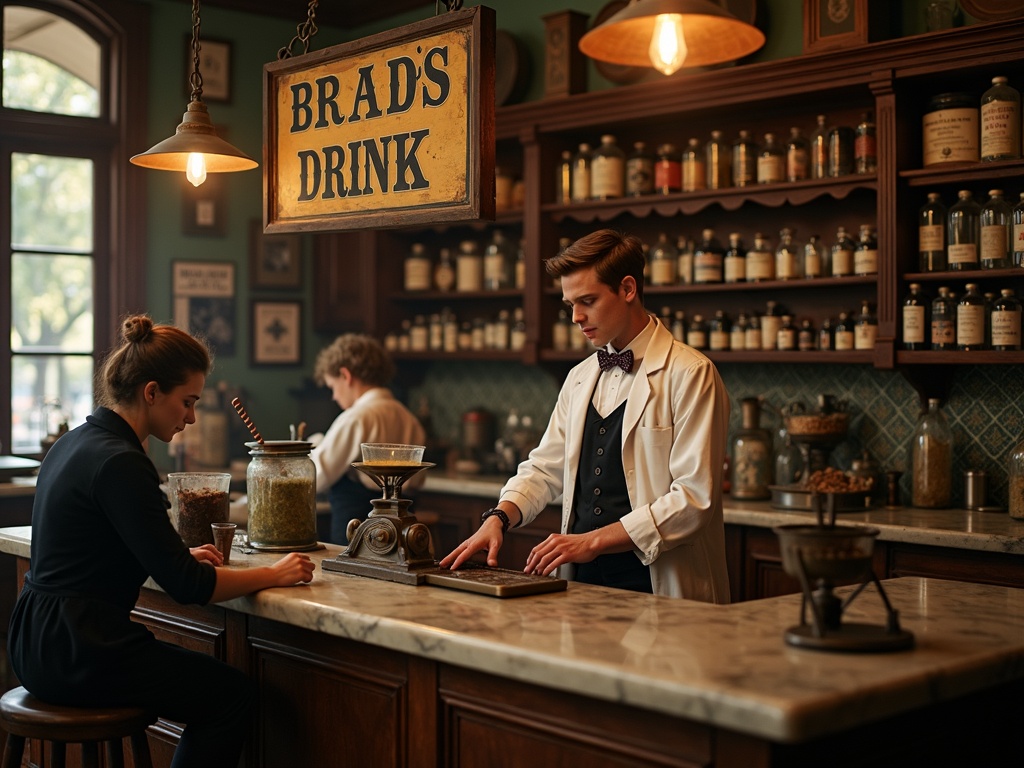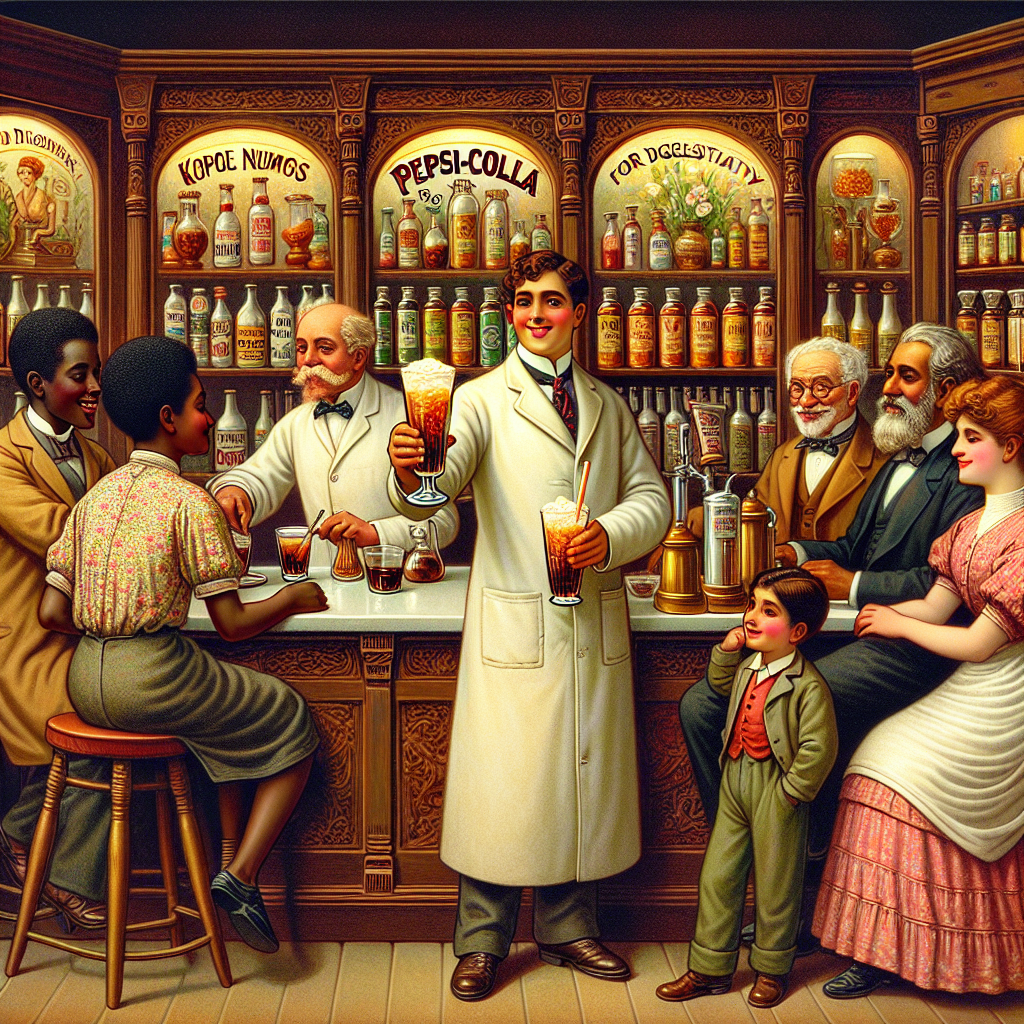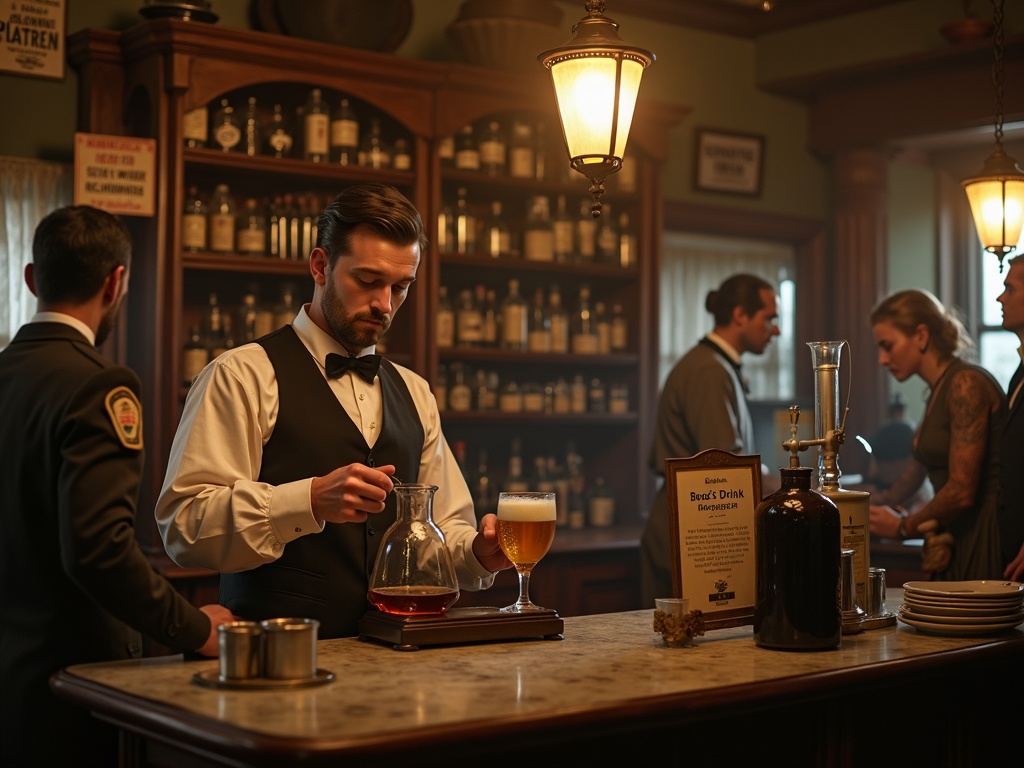No products in the cart.
Beverages News, Soft Drinks
When Was Pepsi-cola Invented And Why It Was Made
Caleb Bradham invented Pepsi-Cola in 1893 as “Brad’s Drink” in his pharmacy located in New Bern, North Carolina. Initially developed as a solution to aid digestion, the beverage soon evolved into a popular refreshment that combined medicinal relief with a pleasant, energizing taste.
Table of Contents
Origins of Pepsi-Cola
Pepsi-Cola began its journey in 1893 when pharmacist Caleb Bradham created a unique drink intended to help customers suffering from indigestion, or dyspepsia. Blending health benefits with flavorful ingredients, the beverage was originally introduced under the name “Brad’s Drink.”
Rebranding and Purpose
In 1898, Bradham rebranded the drink to Pepsi-Cola, a title that reflected its intended digestive aid properties (“Pepsi” for dyspepsia) and its energizing ingredients like kola nut extract. This repositioning allowed the drink to resonate more with consumers seeking both refreshment and health benefits.
Original Ingredients
The original formula of Pepsi-Cola was a carefully crafted mixture of:
- Sugar – Used for sweetness and energy
- Water – The base of the beverage
- Caramel – Added color and flavor
- Lemon oil – For citrus tang and aroma
- Nutmeg – A warm spice for depth
- Vanilla – For smoothness and sweetness
- Kola nut extract – Provided caffeine and a distinctive taste
Growth and Expansion
In 1902, the Pepsi-Cola Company was officially incorporated. Bradham’s franchise model allowed for rapid expansion, bringing the drink to a nationwide audience. By 1910, the company operated 240 bottling locations across 24 U.S. states.
Legacy
Bradham’s innovation laid the foundation for one of the world’s most recognized beverage brands. Today, Pepsi-Cola stands not only as a tasty refreshment but also as a symbol of American ingenuity and entrepreneurship. You can learn more about Pepsi’s early history by visiting PepsiCo’s official history page.
The Pharmacist Behind America’s Iconic Cola
I find it fascinating that one of America’s most recognizable beverages started life in a small-town pharmacy. Caleb D. Bradham invented the drink in 1893 inside his New Bern, North Carolina drugstore, where he served customers at his soda fountain. The original creation bore the simple name “Brad’s Drink”, reflecting its humble origins and personal touch.
A Social Hub with Health Benefits
Drugstores during the 1890s functioned as much more than medical supply centers. They served as social hubs where pharmacists crafted beverages with perceived health benefits, combining their pharmaceutical knowledge with entrepreneurial spirit. Bradham understood this concept well, experimenting with various flavors to create a refreshing drink that also supported digestion.
From Local Favorite to Cola Legacy
Although its origin was humble, the formula quickly gained popularity among locals who frequented Bradham’s establishment. The pharmacist’s careful attention to taste and supposed digestive properties set his creation apart from other fountain drinks of the era. This early success laid the foundation for what would eventually become Pepsi’s global legacy.
Bradham’s invention represents a perfect example of American innovation born from practical necessity. His background in pharmacy provided him with the scientific approach needed to balance flavors while creating a beverage that customers believed offered health advantages. The drink’s popularity in his New Bern location demonstrated that he had successfully captured something special in his formula.
The transformation from Brad’s Drink to what we now know as Pepsi-Cola’s timeless choice began with this pharmacist’s dedication to creating something both enjoyable and beneficial. Bradham’s story shows how a single individual with the right combination of scientific knowledge, business acumen, and creative vision could develop a product that would eventually challenge established competitors and become a household name across America and beyond.
The 1893 invention marked the beginning of a journey that would see ownership changes and corporate evolution over the decades. Yet the core spirit of innovation that Bradham brought to his small drugstore remains embedded in the brand’s identity today.

A Beverage with a Purpose: Digestive Relief and Energy
I find it fascinating that Caleb Bradham didn’t set out to create just another sweet drink when he invented Pepsi-Cola. Instead, he had a specific medical purpose in mind – relieving dyspepsia, which we now commonly call indigestion. This approach reflected the popular thinking of his era, where beverages often promised therapeutic benefits alongside refreshment.
The Patent Medicine Era Influence
Bradham’s creation emerged during what historians call the ‘patent medicine era’, a time when many commercial beverages claimed to possess healing properties. Drawing on his pharmaceutical background, he carefully selected ingredients that would deliver both an appealing taste and what he believed were functional health benefits. This wasn’t unusual for the 1890s – consumers expected their fountain drinks to do more than simply quench thirst.
The pharmacist’s approach to Pepsi-Cola’s global legacy began with his understanding of digestive issues that plagued many Americans. Poor diet, stress, and limited medical options made indigestion a common complaint. Bradham saw an opportunity to address this need while creating a profitable business venture.
Marketing Health Benefits Through Taste
Similar to early Coca-Cola formulations, Pepsi was positioned as a health-enhancing fountain drink that customers could enjoy at soda fountains across the country. Bradham’s marketing strategy emphasized the drink’s potential to help customers feel better after heavy meals, making it an appealing option for those seeking both refreshment and relief.
The key elements that made Pepsi-Cola a timeless choice included:
- Digestive support through carefully chosen ingredients
- Energy enhancement for tired customers
- Pleasant taste that masked any medicinal qualities
- Affordable pricing that made regular consumption possible
- Social appeal as a fountain drink experience
Bradham’s pharmaceutical training proved invaluable in this process. He understood how different ingredients might affect the human digestive system and worked to create a formula that balanced therapeutic claims with genuine enjoyment. The resulting beverage offered customers something they could feel good about consuming regularly.
This health-focused approach helped establish trust between the brand and its early customers. People didn’t just buy Pepsi-Cola for its taste – they purchased it because they believed it would improve their well-being. This foundation of perceived health benefits contributed significantly to the brand’s early growth and acceptance in American society.
The connection between Pepsi-Cola ownership and its original health mission has evolved dramatically over the decades. While modern Pepsi no longer makes therapeutic claims, Bradham’s original vision of creating a beverage that made people feel good continues to influence how the company approaches product development and marketing today.
Bradham’s goal extended beyond simple profit – he wanted to create something that genuinely improved his customers’ daily lives. This philosophy of combining pleasure with purpose helped differentiate his cola from competitors and established a loyal customer base that appreciated both the drink’s taste and its promised benefits.

Birth of the Pepsi-Cola Brand in 1898
I find it fascinating that Caleb Bradham made a pivotal marketing decision in 1898 that transformed his local pharmacy drink into what would become a global phenomenon. Bradham renamed his creation from “Brad’s Drink” to Pepsi-Cola, a name that would eventually challenge Pepsi’s global reach across markets worldwide.
The Strategic Name Selection
Bradham chose “Pepsi” specifically because it referenced dyspepsia, a common digestive ailment of the era. This name choice wasn’t accidental—it deliberately highlighted the drink’s intended digestive benefits, positioning it as both refreshing and healthful. However, I must clarify a persistent misconception that continues to circulate today: Pepsi-Cola never actually contained pepsin, the digestive enzyme many people assume was part of the original formula. The name was purely a marketing strategy designed to suggest digestive aid properties without requiring actual medicinal ingredients.
The “Cola” portion of the name served an equally important purpose. It directly referenced the kola nut, an African plant that supplied both caffeine and the distinctive flavor profile that would become synonymous with cola beverages. This ingredient choice connected Bradham’s creation to the exotic and energizing qualities that consumers sought in their beverages.
Formalizing the Brand Identity
Bradham didn’t stop at simply renaming his drink. Recognizing the importance of legal protection for his growing business, he took the crucial step of trademarking the Pepsi-Cola name in 1903. This five-year gap between the name’s creation and its formal trademark registration reflects the entrepreneurial learning curve that many small business owners experience.
The trademark registration formalized more than just legal protection—it crystallized the brand’s identity and mission. By 1903, Bradham had refined his understanding of what made Pepsi-Cola a timeless choice for consumers seeking both refreshment and perceived health benefits.
This strategic branding move laid the foundation for everything that followed. Understanding who owns Pepsi-Cola today requires appreciating how Bradham’s 1898 naming decision created a brand identity strong enough to survive multiple ownership changes, economic challenges, and intense competition over more than a century.
The 1898 transformation from Brad’s Drink to Pepsi-Cola represents one of the most successful rebranding efforts in beverage history, demonstrating how a pharmacist’s local creation could evolve into an internationally recognized name through strategic thinking and clever marketing.

Inside the Original Formula
I find it fascinating that Caleb Bradham’s original Pepsi-Cola formula relied on a carefully balanced combination of simple yet purposeful ingredients. His early recipe included sugar, water, caramel for color, lemon oil, nutmeg, vanilla, and kola nut extract, each serving a specific function in creating what he called “Brad’s Drink.”
The Foundation Ingredients and Their Purpose
The kola nut extract served as the primary caffeine source, delivering a natural energy boost that distinguished Pepsi from other sodas of the era. This ingredient connected directly to the drink’s name and positioned it as more than a simple refreshment. Bradham understood that his customers wanted something invigorating, and the kola nut provided exactly that stimulation they craved.
Sugar and water formed the base, while caramel played a crucial role in establishing the distinctive dark color that consumers now associate with cola beverages. The caramel didn’t just add sweetness—it created the visual appeal that helped establish Pepsi-Cola’s global legacy as a recognizable brand. Lemon oil contributed brightness and citrus notes that balanced the heavier flavors, while nutmeg and vanilla added complexity and warmth to the overall taste profile.
Perfecting the Recipe Through Experimentation
Bradham spent countless hours behind his pharmacy counter refining this formula through trial and error. His pharmaceutical background gave him advantages in measuring and mixing ingredients precisely, allowing him to adjust ratios until he achieved the perfect balance. The pharmacist approached flavor development like he would any medicinal preparation—systematically and with attention to each component’s contribution.
The resulting flavor profile delivered both refreshing qualities and digestive benefits, which Bradham marketed as health advantages. Customers believed they were consuming something that would settle their stomachs while providing pleasant taste and gentle stimulation. This combination of enjoyment and perceived wellness benefits helped establish why Pepsi-Cola remains a timeless choice for consumers seeking both refreshment and satisfaction.
Bradham’s experimentation process revealed his understanding that successful beverage creation required balancing multiple sensory elements:
- He adjusted sweetness levels
- Modified citrus intensity
- Calibrated the caffeine content
These refinements ensured that customers consistently requested his creation over other available options. His pharmacy provided the perfect laboratory for testing different combinations and gathering immediate customer feedback.
The original formula’s success stemmed from its creator’s willingness to continuously refine and improve the recipe based on real consumer response. Bradham didn’t settle for his first attempt—he listened to customer preferences and adjusted accordingly. This iterative approach to product development reflected his commitment to creating something genuinely appealing rather than simply novel.
Understanding who owns Pepsi-Cola from past to present helps explain how this original formula evolved into today’s modern version, but Bradham’s foundational recipe established the flavor principles that continue guiding Pepsi’s development. His careful selection of ingredients and systematic refinement process created a blueprint that influenced cola formulations for generations.
The kola nut extract’s natural caffeine content provided stimulation without the harshness associated with synthetic alternatives, while the vanilla and nutmeg created depth that prevented the drink from tasting flat or one-dimensional. Bradham’s pharmaceutical training helped him recognize how different ingredients would interact and complement each other in the final product.
His decision to use lemon oil rather than other citrus options demonstrated his understanding of how specific flavoring agents would enhance rather than overpower the other components. Every ingredient served multiple purposes—contributing to taste, appearance, or perceived health benefits while maintaining harmony within the complete formula.
When Was Pepsi-Cola Invented? Direct Answer
Pepsi-Cola was invented in 1893, originally created as “Brad’s Drink” by pharmacist Caleb Bradham in New Bern, North Carolina. The beverage underwent its official transformation to Pepsi-Cola in 1898, marking the true birth of the brand we recognize today.
The Original Creation and Purpose
I find it fascinating that Bradham developed this carbonated beverage with a specific dual mission in mind. He wanted to create something that would aid his customers’ digestion while simultaneously providing them with a refreshing, flavorful drink that delivered an energizing boost. This wasn’t just another soda fountain experiment – it was a purposeful creation designed to serve both medicinal and recreational needs.
The timing of this invention places Pepsi-Cola firmly within the late 19th-century boom of patent medicines and carbonated beverages. During this era, pharmacists frequently experimented with various formulations, combining medicinal ingredients with appealing flavors to create products that customers would actually enjoy consuming.
From Brad’s Drink to Pepsi-Cola
The five-year journey from “Brad’s Drink” to “Pepsi-Cola” wasn’t arbitrary. Bradham’s decision to rebrand in 1898 reflected his growing confidence in the formula and his ambitions for broader market reach. The name “Pepsi-Cola” itself derived from two key components:
- “Pepsin” – an enzyme believed to aid digestion
- “Cola” – referencing the kola nut extract that provided caffeine and flavor
This strategic naming choice perfectly encapsulated the beverage’s intended benefits. The digestive aid aspect remained central to the brand’s identity, while the cola component positioned it alongside other popular carbonated drinks of the time. Bradham understood that success required more than just a good product – it demanded effective branding that communicated clear value propositions to potential customers.
The transformation from a local pharmacy creation to a named brand also marked Bradham’s shift from simply serving individual customers to building something with commercial potential. By 1898, he’d moved beyond the experimental phase and committed to developing what would eventually become one of the world’s most recognized beverage brands.
The early marketing efforts emphasized both the refreshing taste and the digestive benefits, creating a unique position that differentiated Pepsi-Cola from pure refreshment drinks. This dual-benefit approach influenced everything from the formula composition to the advertising messages, establishing patterns that would shape the brand’s development for years to come.
Understanding Pepsi’s ownership history helps explain how these foundational elements evolved over time. Bradham’s original vision of combining taste with function created a template that subsequent owners would adapt and refine, but the core concept of delivering both refreshment and perceived benefits remained consistent throughout the brand’s development.
The 1893 creation date makes Pepsi-Cola a product of the Gilded Age, when American entrepreneurship was flourishing and new consumer products were emerging rapidly. Bradham’s timing proved excellent, as he entered the market during a period of growing demand for branded, packaged goods that promised specific benefits to consumers.

From Local Pharmacy to National Brand
Bradham incorporated the Pepsi-Cola Company in 1902 to meet the surging demand for his digestive cola. The transformation from a simple pharmacy counter remedy to a commercial enterprise happened swiftly, with the company selling 7,968 gallons of syrup in its first year alone.
Franchising Strategy Drives Expansion
Pepsi expanded rapidly through franchised bottling operations, a strategic decision that would define its early growth trajectory. This approach was particularly clever because it allowed Bradham to scale his business without massive capital investment. By granting franchises, he could leverage local entrepreneurs’ resources and market knowledge while maintaining brand control.
The numbers speak volumes about this strategy’s effectiveness. By 1910, more than 240 bottling franchises operated across 24 states, creating a distribution network that rivaled established competitors. This franchising model fueled Pepsi’s early national growth and positioned it to compete directly with other emerging soda brands like Coca-Cola.
National Recognition and Market Position
The shift from pharmacy curiosity to national brand marked a pivotal moment in beverage history. Bradham’s formula had evolved beyond its original medicinal claims to become something consumers actively sought for refreshment and taste. This transformation represented more than just geographical expansion—it signified Pepsi’s entry into the competitive national beverage market.
The franchise system also created valuable economies of scale. Local bottlers could adapt to regional preferences while maintaining the core Pepsi-Cola formula, ensuring consistency across markets. This flexibility proved crucial as Pepsi’s ownership navigated the challenges of building brand recognition in diverse markets.
What stands out most about this period is how quickly Pepsi transitioned from Bradham’s experimental digestive aid to a legitimate commercial beverage. The company’s rapid expansion demonstrates both the product’s appeal and Bradham’s business acumen. His decision to franchise rather than attempt direct expansion allowed Pepsi to establish a presence in markets that might have taken decades to penetrate through traditional means.
This foundational period established patterns that would influence Pepsi’s development for decades. The franchising approach created local stakeholders invested in the brand’s success, while the rapid expansion helped establish Pepsi as a timeless choice for American consumers seeking refreshment beyond traditional pharmacy remedies.
Sources:
PepsiCo – “The History of the Pepsi-Cola Company”
The Pepsi Store, New Bern NC – Historical Archives
Encyclopedia of North Carolina – “Pepsi-Cola”
U.S. National Archives – Pepsi-Cola Trademark No. 71,246


